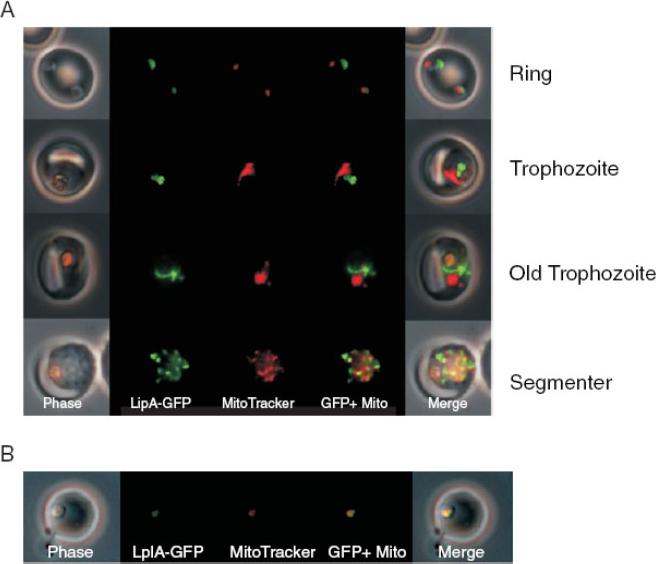PVX_083125 lipoyl synthase, putative
Disruptability [+]
| Species | Disruptability | Reference | Submitter | |
|---|---|---|---|---|
| P. berghei ANKA |
Possible |
PlasmoGEM (Barseq) | PlasmoGEM | |
| P. falciparum 3D7 |
Refractory |
USF piggyBac screen (Insert. mut.) | USF PiggyBac Screen | |
Mutant phenotypes [+]
| Species | Stage | Phenotype | Reference | Submitter |
|---|---|---|---|---|
| P. berghei ANKA | Asexual |
No difference |
PlasmoGEM (Barseq) | PlasmoGEM |
Imaging data (from Malaria Metabolic Pathways)

Localization of LipA–GFP fusion and LplA–GFP fusion constructs overexpressed in P. falciparum. A. The first N-terminal 339 nucleotides of the lipA gene were cloned in frame with green fluorescent protein (GFP). The peptide confers transit of GFP into an organelle distinct from the mitochondrion as shown by co-staining the parasites with MitoTracker CMX Ros. The figure demonstrates the morphological changes of the apicoplast throughout the erythrocytic cycle of the parasites. Phase: phase-contrast image MitoTracker: image. Merge: merge of phase-contrast, GFP and rhodamine channel. B. The first N-terminal 357 nucleotides of the lplA-GFP targets to the mitochondrion. The co-localization of GFP and MitoTracker fluorescence suggests that the LplA N-terminal extension represents mitochondrial targeting sequence. taken of mitochondrion using the rhodamine channel.Wrenger C, Müller S. The human malaria parasite Plasmodium falciparum has distinct organelle-specific lipoylation pathways. Mol Microbiol. 2004 53:103-13.
See original on MMPMore information
| PlasmoDB | PVX_083125 |
| GeneDB | PVX_083125 |
| Malaria Metabolic Pathways | Localisation images Pathways mapped to |
| Previous ID(s) | Pv083125 |
| Orthologs | PBANKA_1357500 , PCHAS_1362100 , PF3D7_1344600 , PKNH_1256700 , PVP01_1210200 , PY17X_1363200 |
| Google Scholar | Search for all mentions of this gene |